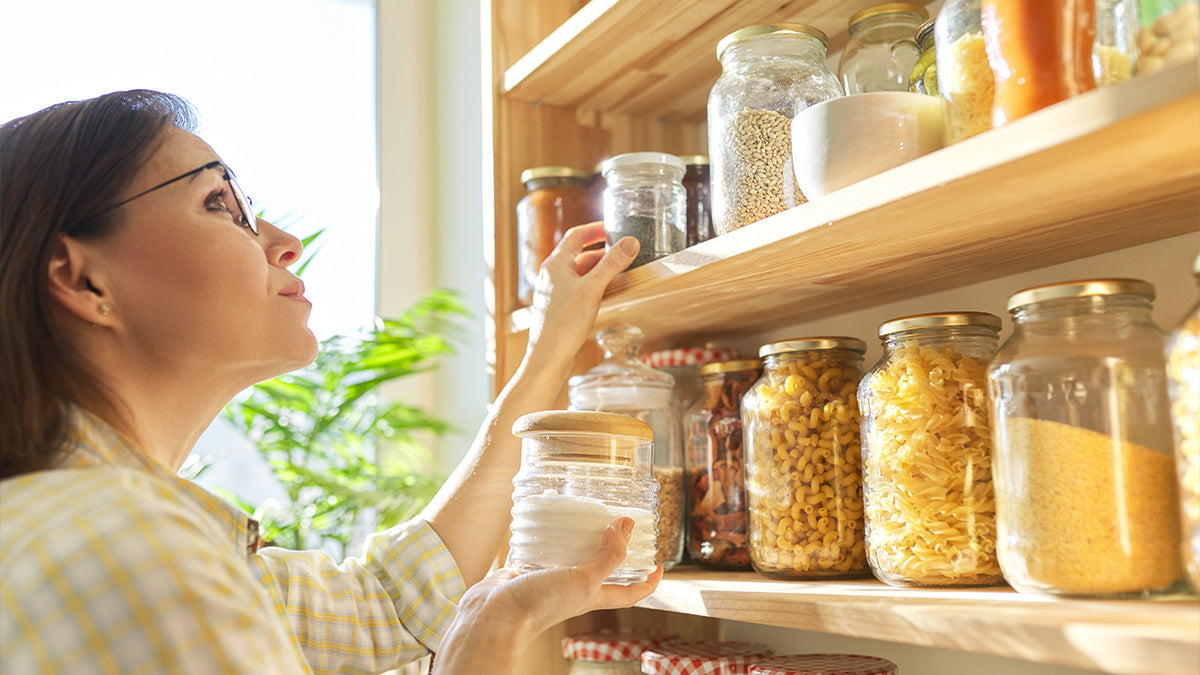Thinking about emergency preparedness can feel overwhelming...
Time and time again, we've seen natural disasters leave families without access to food—from Hurricane Sandy emptying grocery stores within hours to Texas winter storms shutting down supply chains for weeks.
These unpredictable natural disasters remind us that having food stored away provides not just sustenance, but peace of mind when the unexpected happens.
And yet many people put off building an emergency food supply because it seems too complicated or expensive.
The good news?
You don't need to do everything at once! This 30-day step-by-step plan breaks down the process into manageable, affordable steps that won't strain your budget or overwhelm your space.
Before You Begin: The 4 Golden Rules
- Start with what you eat. Don't buy unfamiliar foods your family won't touch. Emergencies are stressful enough! No need to force anyone to eat something they’d never eat.
- Rotate your supply. Use the "first in, first out" method to ensure nothing expires on your shelf.
- Store what you know how to prepare. If you've never cooked dried beans, a power outage isn't the time to learn.
- Don't break the bank. This plan adds just a few items each week to your regular shopping trip.
Week 1: Assessment & Foundation

Days 1-2: Take inventory
Look through your pantry and note what shelf-stable foods you already have. Many families are surprised to discover they're already partway there!
Days 3-5: Create a meal plan
Draft 10-15 simple emergency meals your family enjoys that require minimal cooking. Think peanut butter sandwiches, tuna salad, pasta with sauce, or oatmeal with dried fruit.
Days 6-7: First shopping trip
Your first week focuses on these essential food categories:
Protein sources that require no refrigeration and minimal preparation are your emergency food foundation. Look for options that can be eaten with little to no preparation.
Shelf-stable fats are crucial for calorie density and food preparation. These help make meals satisfying and provide essential nutrients.
Ready-to-eat grains offer quick energy and familiar comfort foods. Choose options that can be prepared with just hot water if necessary.
Our recommendations:
- 2 jars of peanut butter
- 1 large container of oats
- 3 cans of tuna or chicken
- 5 cans of beans (variety)
- Small bottle of cooking oil
Feel free to change these according to your needs!
Week 2: Building Basics

Days 8-10: Water planning
Calculate your water needs (1 gallon per person per day, minimum). Purchase a few gallons or clean containers for water storage.
Days 11-14: Second shopping trip
This week focuses on these key categories:
Long-term carbohydrates form the base of many emergency meals and provide essential energy. These foods have excellent shelf stability and versatility.
Meal enhancers transform basic ingredients into satisfying meals. They add flavor and nutrition to your emergency food supply.
Fruits and vegetables provide essential vitamins and minerals. Even in emergencies, nutritional balance remains important.
Our recommendations:
- 5 pounds of rice
- 2 jars of pasta sauce
- 5 pounds of pasta
- 5 cans of vegetables
- 5 cans of fruit
Week 3: Expanding Options

Days 15-17: Organization
Create a simple inventory system. Even a notebook listing what you have and expiration dates will work.
Days 18-21: Third shopping trip
This week expands your options:
Shelf-stable dairy provides calcium and familiar ingredients for cooking and comfort foods.
No-cook nutrition gives you ready-to-eat options when cooking facilities are limited or unavailable.
Quick energy sources offer portable, convenient nutrition for stressful situations.
Our recommendations:
- Powdered milk
- Dried fruits and nuts
- Canned soups (5-10 cans)
- Crackers (2-3 boxes in sealed packaging)
- Granola bars or energy bars
Week 4: Completion & Tools

Days 22-25: Consider cooking methods
If the power goes out, how will you prepare food? Focus on these essential capabilities:
Food access tools ensure you can open and utilize your stored foods. Without these basic items, your carefully selected foods might remain inaccessible.
Alternative cooking methods allow you to heat and prepare food without electricity. Even the simplest heating capability dramatically expands your meal options.
Fire and heat sources are critical backup systems for both cooking and warmth. These should be stored safely but accessibly.
Our recommendations:
- Manual can opener (essential!)
- Small camp stove with fuel
- Matches or lighter
- Basic cooking pot
Days 26-30: Final shopping trip
This week rounds out your supply:
Morale boosters might seem optional but are psychologically important. These familiar comforts help maintain a sense of normalcy during difficult times.
Flavor enhancers improve the palatability of basic emergency foods. A small investment here makes a huge difference in meal satisfaction.
Nutrient-dense sweeteners provide both practical benefits and enjoyment. Look for options with indefinite shelf life.
Our recommendations:
- Honey (doesn't expire)
- Coffee, tea, or drink mixes
- Comfort foods (chocolate, hard candies)
- Extra spices for flavor
- Any gaps identified in your meal planning
Beyond 30 Days: Maintain & Expand
Congratulations! You now have approximately 2-3 weeks of emergency food for your family.
Remember, you don’t have to do this in 30 days. Although giving yourself a deadline can certainly help speed things up!
Short on time but still want that peace of mind? Our 30-Day Emergency Food Kit includes all the essentials you need—perfectly portioned, packaged for maximum shelf life, and ready to store.
No shopping trips, no planning, no guesswork. Just open the box and instantly gain a month of food security for your family!
Whether you build your own supply or choose our ready-made kit, the most important thing is taking that first step toward family preparedness. Every meal you store is another layer of security for the people you love most.
Have you started building your emergency food supply? Let us know your favorite emergency meals or storage tips in the comments!

